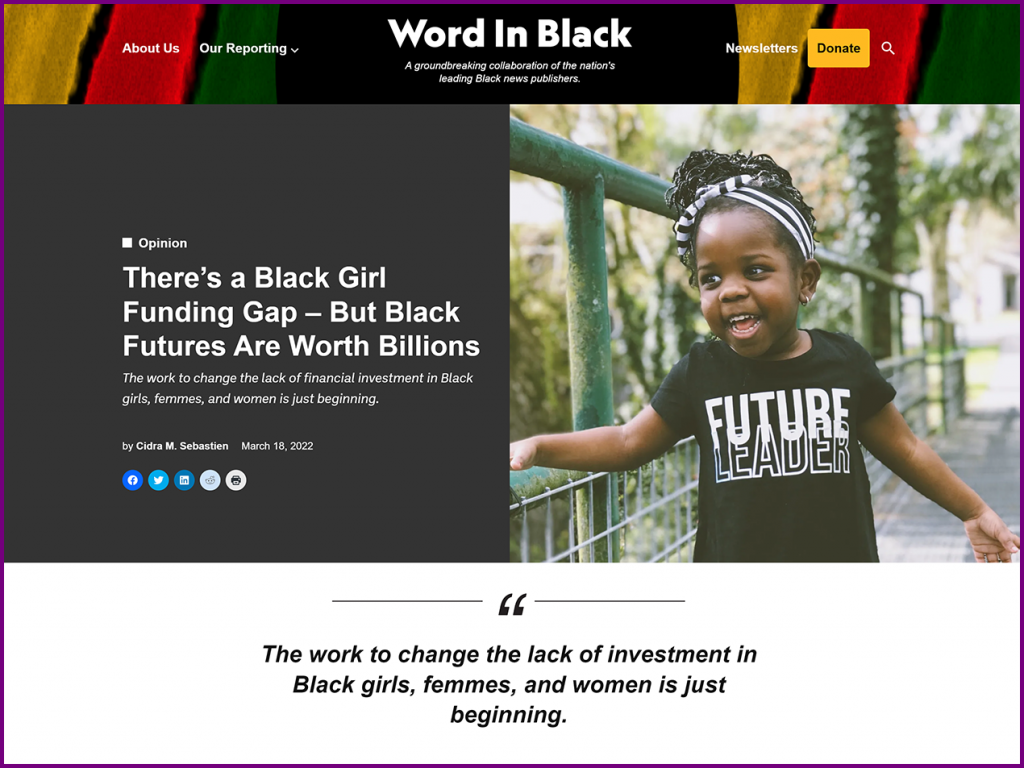
Black Girl Freedom Fund Manager Cidra Sebastien wrote an op-ed for Word in Black about Black Girl Freedom Week. Here’s an excerpt:
There is a blatant gap in funding specifically aimed to support Black girls and femmes. But in February, Black Girl Freedom Week showcased what is possible when we abundantly invest in the dreams, power, joy, and leadership of Black girls, femmes, and gender-expansive youth.
During the week, culture leaders, celebrities, and changemakers elevated the innovations of Black girls. They included Tracee Ellis Ross, Sanaa Lathan, Rashida Jones, Marley Dias, Eva Reign, Susan L. Taylor, Joanne N. Smith, Dr. Monique W. Morris, and Dr. Salamishah Tillet. We celebrated the artistic vision and genius of Black girls and explored how the beauty and fashion industries get to demonstrate their accountability to them.
However, although Black Girl Freedom Week is over, the work to change the lack of investment in Black girls, femmes, and women is just beginning.
That’s because the Black Girl Freedom Week celebration was a core part of the #1Billions4BlackGirls campaign — which calls for an investment of $1 billion in Black girls, femmes, and gender-expansive youth by 2030 — and the Grantmakers for Girls of Color’s Black Girl Freedom Fund (BGFF), which seeks to disrupt deeply embedded racial and gender biases in philanthropy.
According to the seminal 2017 Ms. Foundation Pocket Change report, the most recent study of how foundations distribute money to women and girls of color, less than $15 million of $365 million (4.2%), was specified as benefitting Black women and girls. The median size of grants benefitting Black women and girls was $18,000, compared to a median of $35,000 for all foundation grants.
This trends with the Philanthropic Initiative for Racial Justice findings that in 2018, only 6% of philanthropic dollars supported racial equity work, and only 1% supported racial justice work.
During the Black Girls as Philanthropists panel, Jamison Ford, a 14-year-old who sits on the BGFF Grantmaking Council, shared that “when it comes to philanthropy and investment, Black girls, femmes, and gender-expansive youth often can come last when it comes to investment. Or, we’re not even asked what kind of investment we need for ourselves and our communities. But who better to ask than us?”
Ford’s role on the decision-making side of philanthropy was unexpected, “I never imagined someone like me working in philanthropy. I always imagined a man in a suit and tie sitting at a big table.”
Yet, with insights from Ford and other Black girls and youth, the Black Girl Freedom Fund has distributed $4.5 million to over 70 Black girls-serving organizations around the country within the last two years.
“Being under-resourced means our girls have no space to be mediocre, to fail, to get it wrong, to make mistakes,” assessed Dr. Ramatu Bangura, Executive Director of Children’s Rights Innovation Fund. During her panel, Dr. Bangura emphasized that “historically, Black girls accept investments with the understanding that they’ll only have one shot at success. We know that our best ideas come from freedom and inspiration.”
In a conversation about Black Girls Driving the Culture,Tracee Ellis Ross reminded us that Black girls become Black women, the most civically engaged racial group and power players shaping our politics and labor force, despite being grossly underfunded, under-resourced, and underestimated. Even as an award-winning actress, producer, and CEO, she shared that it took 10 years to get her hair care line, Pattern, off the ground.
There is no social justice movement that does not uniquely impact Black girls, femmes, and gender-expansive youth where they are not already exhibiting leadership. They are on the front lines of racial and gender justice movements, organizing across identities and communities to advance justice for all of us. Our collective future depends on bold investments in their futures.
Read the op-ed on Word in Black.

